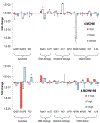Toxicity Assessment of 4-Methyl-1-cyclohexanemethanol and Its Metabolites in Response to a Recent Chemical Spill in West Virginia, USA
- PMID: 25961958
- PMCID: PMC6247413
- DOI: 10.1021/acs.est.5b00371
Toxicity Assessment of 4-Methyl-1-cyclohexanemethanol and Its Metabolites in Response to a Recent Chemical Spill in West Virginia, USA
Abstract
The large-scale chemical spill on January 9, 2014 from coal processing and cleaning storage tanks of Freedom Industries in Charleston affected the drinking water supply to 300,000 people in Charleston, West Virginia metropolitan, while the short-term and long-term health impacts remain largely unknown and need to be assessed and monitored. There is a lack of publically available toxicological information for the main contaminant 4-methyl-1-cyclohexanemethanol (4-MCHM). Particularly, little is known about 4-MCHM metabolites and their toxicity. This study reports timely and original results of the mechanistic toxicity assessment of 4-MCHM and its metabolites via a newly developed quantitative toxicogenomics approach, employing proteomics analysis in yeast cells and transcriptional analysis in human cells. These results suggested that, although 4-MCHM is considered only moderately toxic based on the previous limited acute toxicity evaluation, 4-MCHM metabolites were likely more toxic than 4-MCHM in both yeast and human cells, with different toxicity profiles and potential mechanisms. In the yeast library, 4-MCHM mainly induced chemical stress related to transmembrane transport and transporter activity, while 4-MCHM metabolites of S9 mainly induced oxidative stress related to antioxidant activity and oxidoreductase activity. With human A549 cells, 4-MCHM mainly induced DNA damage-related biomarkers, which indicates that 4-MCHM is related to genotoxicity due to its DNA damage effect on human cells and therefore warrants further chronic carcinogenesis evaluation.
Figures





References
-
- Cooper WJ Responding to crisis: The West Virginia chemical spill. Environ. Sci. Technol 2014, 48 (6), 3095. - PubMed
-
- Elk River Chemical Spill Health Effects Findings of Emergency Department Record Review, 2014; http://www.wvdhhr.org/Elk%20River%20Chemical%20Spill%20Health%20Effects%....
-
- Rosen JS; Whelton AJ; McGuire MJ; Clancy JL; Bartrand T; Eaton A; Patterson J; Dourson M; Nance P; Adams C WV TAP Final Report; WV TAP, 2014.
-
- Whelton AJ; Rosen JS; Clancy J; Clancy T; Ergul A The Crude MCHM Chemical Spill 10-Home Study: Tap Water Chemical Analysis, 2014; http://www.wvgazette.com/assets/PDF/CH619157.pdf.
-
- Whelton AJ; McMillan L; Connell M; Kelley KM; Gill JP; White KD; Gupta R; Dey R; Novy C Residential tap water contamination following the Freedom Industries chemical spill: Perceptions, water quality, and health impacts. Environ. Sci. Technol. 2014, 49 (2), 813–823. - PubMed
Publication types
MeSH terms
Substances
Grants and funding
LinkOut - more resources
Full Text Sources
Other Literature Sources
Molecular Biology Databases

